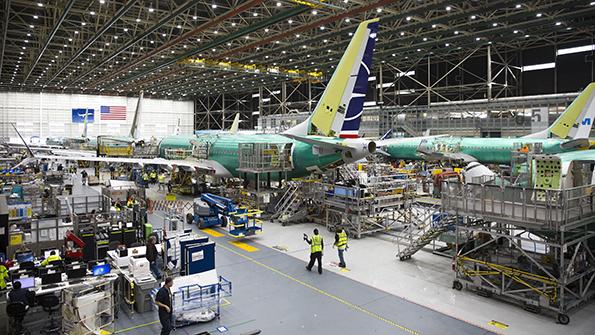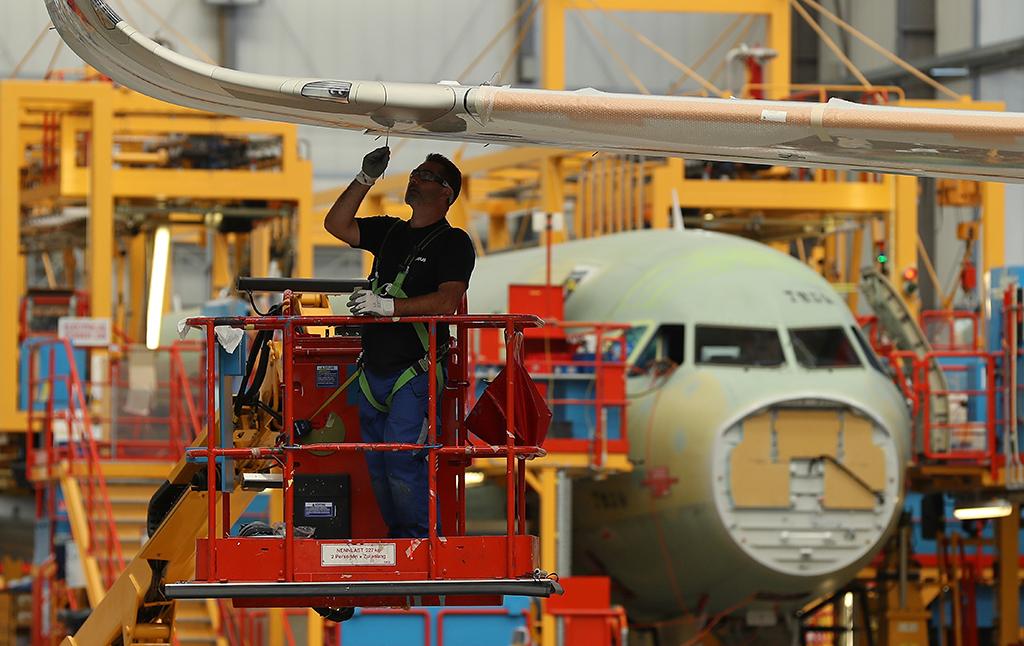Airbus, Boeing Plans Bring 2021 Deliveries In Line With 2019 Levels

Nine months after the coronavirus pandemic broke out globally, Airbus and Boeing are finalizing their 2021 production plans, with adjustments to what many see as the “new normal.”
That is meant to define a state that is sustainable even as circumstances change dramatically. But as the pandemic continues and recovery in key markets is slowing or even reversing with new outbreaks, doubts remain that industry players have adjusted enough to reflect actual demand.
- Airbus and Boeing plan for around 1,100 deliveries in 2021
- A320neo rate increase and further widebody cuts are possible
Under current plans, Airbus and Boeing would deliver around 1,100 aircraft in 2021, with most of the uncertainty centering on how many of the stored Boeing 737 MAXs will be delivered, how quickly MAX production is ramped up and whether Airbus moves ahead with a rate increase on the A320neo family at some point in the second half of 2021.
The two OEMs’ combined output is well below the 1,583 aircraft handed over to customers in 2018. But it is roughly in line with the 1,150 reached in 2019, the year that saw the major impact of the MAX grounding (starting in March) but not yet that of COVID-19. This year, through the end of September, Airbus and Boeing delivered a combined 439 aircraft, implying that civil aircraft production is heading for a relatively steep rise very soon. In addition, 387 delivered MAXs will be added to the already available capacity if and when the global grounding of the type is lifted in the coming weeks.
“Our analysis continues to demonstrate the lack of recovery in global airline traffic sufficient to support demand for current production rates,” Agency Partners analyst Sash Tusa wrote in a research note to clients. “The primary uncertainty is the ability of Airbus to deliver commercial aircraft to its customers, with the A230neo family the standout challenge,” Bernstein Research analyst Douglas Harned commented in an Airbus-focused release.
Nonetheless, Boeing is keeping to its earlier announced plans to slash widebody production rates by 50% by 2021, while simultaneously hoping to gradually restore 737 production to 31 per month by the start of 2022.

The exact size and timing of the 737 rate increase will be dictated by the pace of the overall traffic recovery and also by Boeing’s ability to remarket and reconfigure a large portion of the approximately 450 undelivered aircraft in storage, according to company executives. “We now expect delivery of about half of the aircraft currently in storage by the end of the year [2021] and the majority of the remaining in the following year,” says Boeing Chief Financial Officer (CFO) Greg Smith. An Aviation Week analysis finds that about 60 of the stored aircraft are without a customer due to cancellations and orderbook reshuffling during the model’s 19-month grounding. Smith warns that the timing of the 737 production rate ramp-up profile “continues to be dynamic.”
Boeing’s current scenario has global traffic recovering to 2019 levels in about three years. Although the U.S. domestic passenger market is showing signs of a steady recovery, the slower pace of growth in the international air travel sector is weighing heavily on the company’s widebody plans—particularly those for the 787. With production of the 787 due to be consolidated from mid-2021 onward solely in South Carolina—at a reduced rate of only six per month, compared to the current combined output of 10 per month with Everett, Washington—the OEM warns that further downward trimming may be considered.
Boeing says it has a “large number”—believed to be around 50—of undelivered 787s in the inventory, and together with the slower than expected recovery in international traffic, Smith says the company will “continue to assess the downside risk of our production rates going forward.”
The combined 777/777X rate, which is also slowing from the current five per month to just two per month in 2021, looks likely to remain at this level for some time. Boeing also hints that the target date for entry into service of the 777-9, the first variant of the 777X family, could also slide into 2022. Although the company already announced this year that initial deliveries would not be in 2021 as originally expected, Boeing CEO Dave Calhoun suggests that could be delayed even more.
“As with any development program, there are inherent risks that can affect schedule,” he says. “While we continue to drive toward entry into service in 2022, this timing will ultimately be influenced by certification requirements defined by the regulators.”
Though production rates are not yet being revised, Boeing is cutting more jobs, primarily in its commercial businesses. An initial target of 16,000 reductions announced this year has grown to 30,000 by 2022, with a combination of voluntary and involuntary programs. Boeing plans to have 130,000 employees by the end of 2021. The company posted a net loss of $466 million, or $0.79 per share, in the third quarter as revenues fell 29% to $14.1 billion, led by a 56% drop in Boeing Commercial Airplanes business unit revenues.
In spite of anticipated overcapacity, Airbus continues to consider raising single-aisle production rates from 40 aircraft per month to 47 at some point in 2021, a move that would be “backed by the backlog,” according to CEO Guillaume Faury.
The manufacturer’s current production and supply plan foresees it possibly raising output by the end of the second quarter of 2021, though that is by no means certain. An earlier version of the plan anticipated such a rise by the beginning of the second quarter. Airbus pushed that over three months due to market conditions. “We are in a lower-for-longer scenario,” Faury says. Nonetheless, he stresses, “It is important that the supply chain is prepared, and we expect suppliers to be committed and ready.”
Extended market weakness could lead Airbus to delay a decision to increase output even further into the second half of 2021. And one important supplier, MTU Aero Engines, is voicing caution. “There is a certain skepticism [among suppliers] that this will really happen,” CEO Reiner Winkler says. “We are assuming rate 40 but can be flexible and react quickly. I would wait a little more before we make financial commitments.”
Thales, another important Airbus supplier, is expecting production levels will be below those publicly announced by the OEM for its own restructuring plan, yet Faury points out that “rate 40 is solid.”
Agency Partners’ Tusa also is not so sure the rate increase is coming. He believes keeping those plans alive is one way to prevent customers from deferring deliveries at no cost if they can demonstrate that Airbus production is below a level necessary to comply with contractual obligations. And it may also keep airlines away from the temptation to order cheap 737 MAXs.
“Airbus might need a narrowbody rate increase to offset—both in volume terms for its suppliers and financially for investors—the potential impact of further cuts to the A350 and A330 widebody programs,” Tusa also contends. He thinks A330 demand will be “especially weak” in 2021-22 and that A350 production at five aircraft per month looks “similarly unsupported.”
Faury points out that the A330 remains “an important piece of the puzzle.” Airbus has reduced the production rate of its smallest and oldest active widebody program to two aircraft per month, which Faury says is still “sustainable.” “[The A330 has the potential] to be a very good aircraft to move out of the pandemic,” he says. “Airlines will be looking for very cost-efficient solutions.”
The A330’s very low level of production has raised questions about its future: Will it be dumped as Airbus aims to stem overall losses? That such a move would create a Boeing 787 monopoly is a key reason it is unlikely to happen. Airbus had been pricing the A330neo aggressively in pre-COVID-19 campaigns, but its backlog—marked by large and highly questionable orders from AirAsia X and Iran Air—remains weak. Faury also forecasts that airlines will need to replace the in-service A330 fleet in due course. Unlike the case for narrowbodies, Airbus does not anticipate increased output for the A350 “in the foreseeable future.”
In the first nine months of 2020, Airbus delivered 341 aircraft, 230 fewer than a year ago. The deliveries include: 18 A220s, 282 A320-family aircraft, nine A330s and 32 A350s. The OEM has delivered 155 fewer narrowbodies and 75 fewer widebodies than in 2019.
Single-aisle production was cut this year from more than 60 aircraft to 40. A350 rates were reduced from 10 aircraft per month to six and later to five. A330 production was halved.
Airbus delivered a total of 135 aircraft in the third quarter. “Production and deliveries now converge,” says Faury. Airbus still has an inventory of 135 aircraft that have been built but not delivered. But according to CFO Dominik Asam, only 10 or so of the 135 aircraft are actual white tails with no customers; the vast majority are aircraft for which deliveries have been deferred by 1-2 years.
While Airbus recorded a negative free cash flow before mergers and acquisitions and customer financing of €11.8 billion ($13.8 billion) for the first nine months of the year, more than twice the amount of 2019, cash flow turned to a positive €600 million in the third quarter as the number of aircraft deliveries grew and benefits from cost cuts became visible.
In the commercial aircraft business, Airbus suffered a 33% decline in revenues to €7.7 billion in the third quarter, compared to a 43% drop in the first nine months, indicating that its financial performance is slowly improving. The unit posted a €591 million operating loss, compared to a €1.12 billion profit a year earlier. Restructuring charges of €1.2 billion weighed heavily on group results, €981 million of which are recognized in the commercial aircraft division as the company moves ahead with job cuts and other cost-cutting measures.
COMPLIMENTARY WEBINAR:
November 24, 11:00 EST / 16:00 GMT
With regulators in the U.S. and Europe about to poised to unground the 737 MAX, Boeing’s 18-month nightmare is finally coming to an end. But how long will it take for airlines to get grounded and undelivered aircraft back into service? What kind of pilot training is required? And how quickly will Boeing ramp up production, given the COVID-induced slump in demand for new airplanes.







